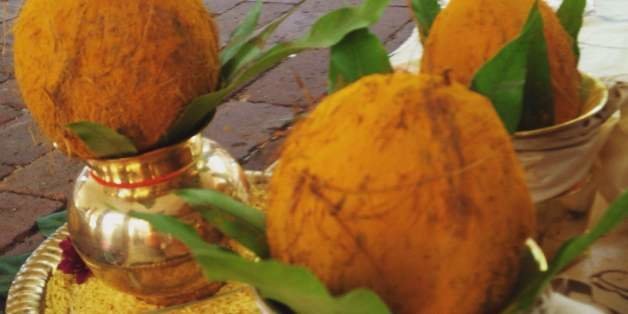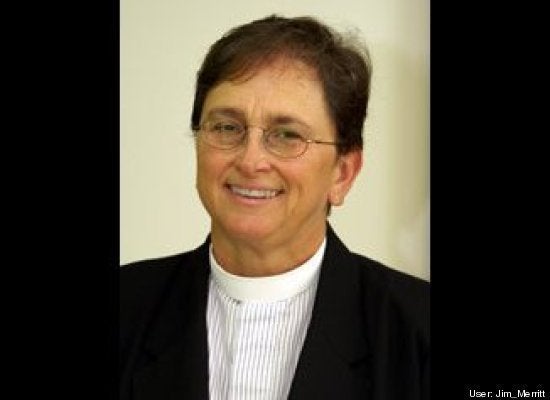
This post originally appeared on Yagnaram's blog.
Last month, I officiated at the marriage of two wonderful women. This was the first wedding I ever conducted, and it seemed fitting to me that it should be a same-sex marriage. The venue was a historic outdoor market in Philadelphia. Tourists would occasionally wander through as the mandap was being set up, consistently asking:
"What kind of event is this?" ("A wedding.")
"Is this a WEDDING?!?!" ("...Yes.")
"What's that incense you're burning? It's so lovely!" ("It's nag champa.")
The kalashas were set up and dressed with silk, the area around the havan kund with was decorated with mango leaves and fresh flowers. To my right, several friends of the brides were chatting while making a backdrop from beautiful red saris and marigolds. The traditional sounds of nadaswaram were playing softly (as softly as nadaswaram can be, anyway) in the background. The brides processed in and sat down. The rites went smoothly.
Many of the guests remarked to me later that this wedding was so beautiful. I personally think most weddings are beautiful, but many of these individuals had never attended a Hindu wedding before, so I understood that they were specifically commenting on the beauty of this context. Hindu weddings certainly are stunning affairs, with lots of bright colors, fresh flowers, the sounds of the ritual fire burning and the scent of incense. For me, as a queer person, the beauty of vivah samskara (marriage rites) is in the meaning and the context. People like me are still denied the right to marry in many places around the world, and so to not only witness, but also officiate, this marriage was especially joyful. What I performed for this couple, and what I will describe briefly below, is a form of marriage called gandharva vivah, a form of marriage that in antiquity was practiced by third-gender or queer individuals*. Gandharva vivah is especially beautiful, I believe, not just because of its usage by third gender people, but also because many of the prayers transcend the patriarchal structures of traditional marriage. These rites may change slightly across different traditions, but the core portions remain the same.
Preliminary rites are first performed like the cleansing of the space to make it pure and suitable for worship and prayers for the removal of obstacles. After the sankalpam, or dedication, is chanted, the familial lineages of both partners will be chanted aloud for all to hear, which is a way to honor each set of ancestors. The parents of either individual will come and pour water over a coconut held by the couple, symbolizing their blessings over this marriage. Then the spouses-to-be will perform what is my favorite part of the wedding rites, hṛdaya sparśa. The couple faces each other. They touch each others heart, and recite a mantra:
Who has given this heart and to whom?
Love has given unto love.
Love is the giver, love is the receiver.
Love has entered the ocean of love.
I receive you through love.
Oh love, this heart is yours.
I love this part because it is so gender neutral. The mantra does not refer to a woman giving herself to a man or vice versa, but love giving love and love receiving love. It reaffirms the fact that marriage is not an institution reserved for straight couples; it is for two souls who simply wish to give themselves to each other in totality.
The fire is ignited. Lord Agni, god of fire, is the priest of the Gods, and is a divine witness to all marriages. The priest will conduct a homam, chanting sacred suktas and offering ghee into the flames with each chant of "swahā." The couple will then exchange rose garlands. This exchange of garlands is a universally accepted part of Hindu marriages. It hearkens to the story of how Mother Lakshmi decorated Lord Vishnu with a garland, choosing Him as Her husband over all other gods.
The couple will take each others hand and make the saptapadi -- seven steps around the fire. This is perhaps the most iconic part of Hindu marriages, so often focused on in films. With each step, the couple recites a different prayer: "May Lord Vishnu lead you to strength. May Lord Vishnu lead you to power. May Lord Vishnu lead you to happiness..." They complete the circle and say to one another: "Be my companion for life, fixed in seven vows. May I attain companionship with you. Do not break this bond. You are a friend of mine, henceforth our mirth or miseries are same for us..." In making these steps together, their bond is solidified, that they may walk together in life, through all things. This reminds us that at its core, marriage is based on mutual respect, friendship and growth. Marriage exists for people to grow spiritually together, to assist each other in the trials of life, to embrace the joys (and yes, occasional monotony!) of everyday life together.
The couple and the officiating priest will then make purnahuti, a final offering, into the fire. Then the priest, families, and assembled guests will bless the couple with rice and flower petals. It is a communal celebration of love, and in this context, of queer love in particular.
It should go without saying that queer love is no different than straight love. Queer people in love enjoy the same tender embraces as straight, cisgender people do. A wedding between two queer people should not be any different than a wedding of a heterosexual man and woman. Of course, that is easier said than done. LGBTQ people in love might experience the same hardships as straight people do, but in addition to that, they also have to all of the additional trials and difficulties imposed by society's discrimination, as well as the risk of hate crimes and violence, and the disapproval of family, friends, co-workers and strangers. In light of that, LGBTQ people in love, everywhere, but especially in my faith community, should be lifted up and celebrated. Their strength in the face of opposition should be an inspiration to all.
LGBTQ people are still fighting to give and receive love, for our love to be seen as equal in the eyes of our governments, our families, and our peers. Yet, "Love has entered the ocean of love," and no one can reverse that flow.
On June 26, the United States Supreme Court ruled that same-sex couples have a right to marriage under the 14th Amendment of the U.S. Constitution. Such a victory should be celebrated everywhere, and for me, the joy I feel is coupled with a commitment to continue fighting until LGBT people receive full equality. Let's enjoy this moment for we must continue working hard for our collective liberation.
*For more information and scriptural references on this topic, please read Amara Das Wilhelm's book, Tritiya-Prakriti: People of the Third Sex.
Also on HuffPost:
